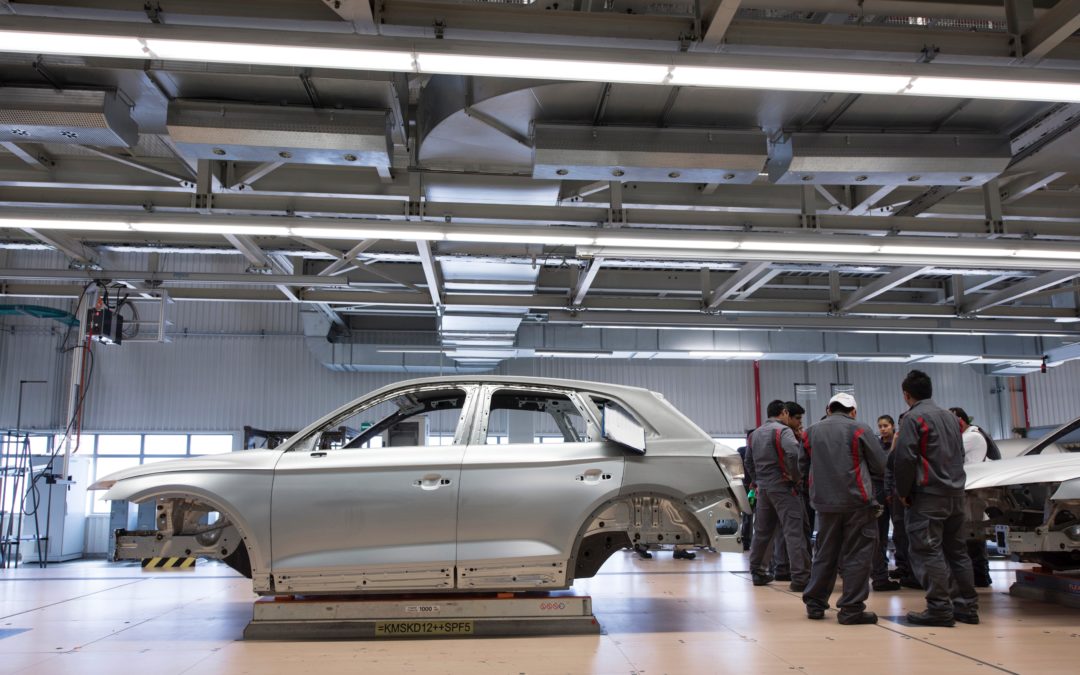As new generations of vehicles get more complex and advanced, new standards for cleanliness must be reached in the manufacturing, assembly, testing, and development of automotive parts and processes. Keeping automotive cleanrooms clean is more than a quality issue — it’s also a safety issue, an environmental issue, and an economical issue.
Let’s take a look at some of the problem areas to assess in your automotive cleanroom with regards to cleanroom cleaning protocols, and a few solutions you can employ in your facility today.
Cleanroom Cleaning Solutions in Automotive Cleanrooms
When it comes to cleanroom cleaning in your automotive cleanroom, take a look at the areas that require the most attention: the surfaces in your cleanroom, the air that fills it, and the equipment and products it contains.
Automotive Cleanroom Surfaces
Surfaces within your cleanroom include the walls, floors, cleanroom tables and furnitures. In automotive cleanrooms, oil or grease spills could not only threaten the quality of your cleanroom but could also create slippery surfaces and a hazardous work environment. Your facility is responsible for maintaining clean surfaces in order to reach your cleanroom classifications, but also to provide a safe area for employees to conduct work, and protect your products from contamination.
Solution: The solution for keeping surfaces within your automotive cleanroom clean is to maintain clean floors by following a schedule with daily sweeping and mopping, and sticking to weekly thorough cleaning and sterilization of all surfaces. Your cleanroom cleaning protocol should be clearly understood by all employees, posted in a visible location in the cleanroom, and regularly reviewed with quality checks.
Automotive Cleanroom Air
In automotive cleanrooms, air quality issues can threaten your products as well as your personnel. If you work in an environment with exhaust and other fumes, proper air quality management is crucial.
Also, modern automotive cleanrooms are responsible for developing and testing parts that are smaller with a larger, more efficient output, more advanced computers and sensors, and other innovations in automotive technology. As parts become smaller and more complex, even the tiniest particles can prove a significant threat to cleanroom operations.
Keeping air quality standards to a strict level is essential for a clean environment. Particle count and size filtration requirements will change depending on the parts your facility handles whether it’s power steering, brakes, or electrical components. While these standards may be provided in your cleanroom classification, you may also need to reach air quality standards for your specific industry or application.
Solution: To keep your cleanroom air as clean as possible, it’s important to make sure your cleanroom filtration system is working properly to comply with classification standards. Check and replace pre filters as necessary and make sure HEPA filters are effectively reaching particle count and size requirements.
Automotive Cleanroom Equipment & Products
The equipment and products your cleanroom supports must also be regularly cleaned in order to achieve control over the cleanroom environment. Some amount of contamination is unavoidable, as all parts and equipment have holes, crevices, and edges that can’t always be completely cleaned. The goal of cleanroom cleaning is to minimize contamination to an acceptable level where the product quality and consumer safety are not at risk.
Solution: Inspect equipment regularly, and have employees use correct protective equipment to limit contact with equipment and parts. Fortunately, modern cleaning systems are available to clean equipment and the parts you fabricate to remove any residue, debris, and bacteria.
Prioritize Automotive Cleanroom Cleaning
Regular and thorough cleanroom cleaning is the best solution to minimize contamination risks, promote employee safety, and guarantee product quality within your automotive cleanroom. Establish a cleanroom cleaning protocol that fits the needs and cleanliness level of your facility. Make sure all necessary employees are trained in how to properly clean the cleanroom without reintroducing contaminants. Then enforce a cleaning schedule that allows you to easily meet your cleanroom classification requirements.
Cleanroom Design and Cleanroom Cleaning
Your cleanroom design should be able to support a consistently controlled environment and your cleaning protocol, which is why cleanroom design and cleanroom cleaning go hand-in-hand.
All wall and floor surfaces, furniture, lighting, and other cleanroom components should be able to support the chemicals and processes you use to clean your cleanroom. They should be made of materials that are non corrosive and non particle-shedding. The cleanroom should also have plenty of available storage to stow
cleaning supplies and equipment. This will help to limit contamination from entering and exiting the facility each time it needs to be cleaned.
Finally, the cleanroom should be designed to maintain cleanliness on its own, through proper filtration and a carefully mapped airflow pattern, with surfaces that limit contamination or particle buildup. A properly designed cleanroom will still require cleaning, but the risk of contamination will be significantly reduced.
Have everything you need to keep your automotive cleanroom clean? Angstrom Technology can help! We can help you design a cleanroom that helps your facility stay clean, so you’ll never have to worry about meeting your classification requirements. Give us a call to learn more.


